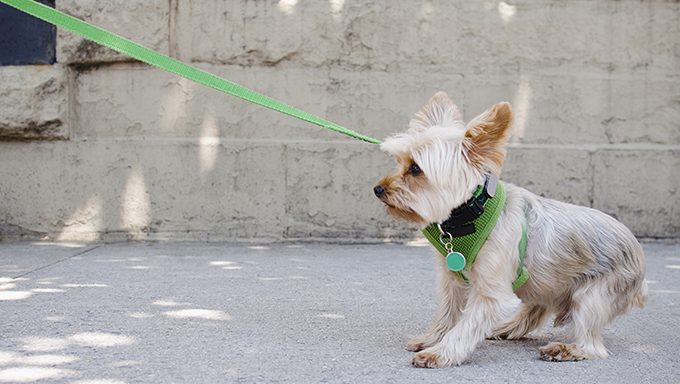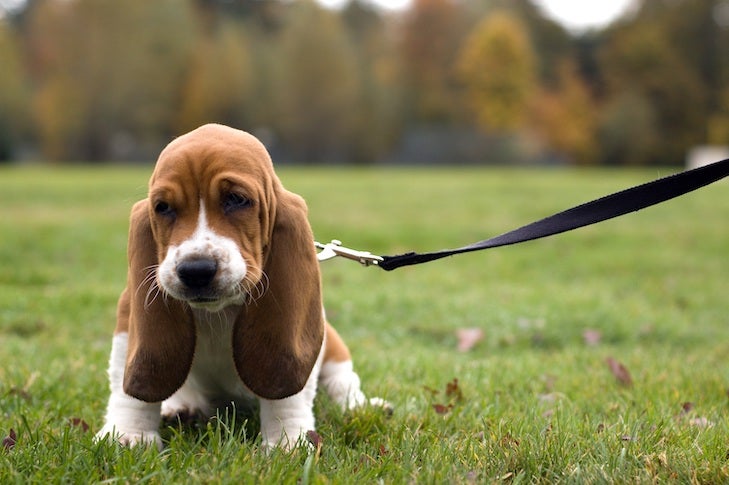Train your puppy or dog to walk on a leash by following these tips for good leash behavior. Walking on a leash is an important skill for dogs to learn, as it ensures their safety and allows for enjoyable walks together.
With consistency, patience, and positive reinforcement, you can teach your furry friend to walk beside you without pulling or tugging on the leash. We will discuss effective leash training techniques that will help your puppy or dog become a well-behaved walking companion.
So, let’s get started and help your canine companion master the art of walking on a leash!

Credit: www.youtube.com
The Importance Of Leash Training
Leash training is an essential skill for all dogs and puppies. By teaching them how to walk on a leash, you ensure good behavior and control during walks, promoting a safe and enjoyable experience for both pet and owner.
Leash training is an essential aspect of owning a puppy or dog. It not only helps you maintain control of your furry friend but also ensures their safety and the safety of others. A well-trained dog who walks calmly on a leash can be a joy to be around, creating a pleasant and stress-free experience for both the dog owner and those they encounter. In this article, we will explore the importance of leash training, how to build a strong foundation, and the benefits of leash training.
Building A Strong Foundation
Training your puppy or dog to walk on a leash starts with building a strong foundation. It requires patience, consistency, and positive reinforcement. Begin by introducing your furry friend to the leash, allowing them to become familiar with its presence. Use treats and praise to associate positive experiences with the leash, making it a desirable accessory for your dog to wear. Slowly progress by attaching the leash to their collar or harness, providing gentle guidance while ensuring their comfort. Focus on short, frequent training sessions to prevent overwhelm and keep your furry friend engaged.
Once your puppy or dog is comfortable wearing the leash, you can begin teaching them basic leash manners. Start in a quiet, familiar environment to minimize distractions. Use a firm yet gentle grip on the leash, keeping it loose to allow your dog some freedom to explore. Encourage them to walk beside you using verbal cues such as “heel” or “let’s go.” Reward their compliance with treats and praise. Repeat this process consistently, gradually increasing the difficulty by introducing distractions and practicing in different locations. By building a strong foundation, you set the stage for successful leash training.
Benefits Of Leash Training
Leash training offers numerous benefits for both you and your dog. Let’s take a look at some of the advantages:
- Improved Safety: Walking on a leash ensures that your dog stays close by your side, reducing the risk of them running off or getting into potential dangers such as traffic or unfamiliar territory.
- Better Control: Leash training gives you control over your dog’s movements, allowing you to guide them away from potentially hazardous situations or prevent unwanted behaviors like jumping on people or chasing other animals.
- Enhanced Bonding: The consistent training and positive reinforcement involved in leash training can strengthen the bond between you and your furry companion, improving your overall relationship.
- Public Etiquette: A well-behaved dog on a leash is perceived positively by others, creating a pleasant walking experience for both you and those you encounter. It also demonstrates responsible pet ownership.
- Improved Mental Stimulation: Walks provide mental stimulation for dogs, allowing them to explore new scents, sights, and sounds. Leash training facilitates this experience while ensuring their safety and your peace of mind.
Remember, leash training takes time and patience. Be consistent with your training efforts, and remember to always reward your dog’s good behavior. With practice, your puppy or dog will become a well-behaved and happy walking companion.
Choosing The Right Leash And Collar
Help your puppy or dog become a well-behaved walker with the right leash and collar. Train them to walk on a leash with good behavior, ensuring their safety and enjoyment on walks.
When it comes to training your puppy or dog to walk on a leash, choosing the right leash and collar is crucial. The leash and collar you select can greatly impact your pet’s comfort and safety during walks. In this section, we will explore the different types of leashes and considerations for collars, helping you make an informed decision for your furry friend.Types Of Leashes
There are various types of leashes available, each offering its own unique benefits. Here are some popular options to consider:- Standard Leash: This is the most commonly used leash, typically made of nylon or leather. With a length between 4 and 6 feet, it provides sufficient control while allowing your dog some freedom to explore.
- Retractable Leash: These leashes offer adjustable lengths, allowing your dog to roam further during walks. While they provide more freedom, it’s important to use them cautiously, as they can be challenging to control in high-traffic areas.
- Training Leash: Designed specifically for training purposes, these leashes are longer, typically ranging from 10 to 30 feet. They provide more space for your dog to move around and learn obedience commands.
- Hands-Free Leash: These leashes are perfect for active individuals who want to keep their hands free during walks or jogs. They can be worn around the waist or carried across the chest, providing convenience and ease of movement.
Considerations For Collars
In addition to choosing the right leash, selecting the appropriate collar is equally important. Here are some considerations to keep in mind when picking a collar for your dog:- Comfort: Ensure the collar is made from soft and durable material, such as nylon or leather, to prevent irritation and discomfort.
- Size: Choose a collar that fits your dog properly, not too tight or too loose. You should be able to fit two fingers between the collar and your dog’s neck.
- Buckle vs. Clip-On: Collars can either have buckle or clip-on closures. Buckle closures provide enhanced security, while clip-on closures offer convenience for quick removal.
- Safety Features: Opt for collars with reflective strips or LED lights to enhance visibility during nighttime walks, ensuring the safety of both you and your dog.
- Training Needs: Consider using a martingale collar or a head halter for dogs that pull excessively, as these tools can help with leash training and control.
Preparing For Leash Training
Learn how to train your puppy or dog to walk on a leash with good leash behavior. Follow these simple steps to prepare for leash training and enjoy stress-free walks with your furry friend.
Preparing for Leash Training Creating a positive atmosphere The first step in preparing for leash training your puppy or dog is to create a positive and relaxed atmosphere. Dogs are highly attuned to their environment and will pick up on any stress or tension. Establishing a calm and friendly atmosphere will help your furry friend feel more comfortable and open to learning. – Clear any distractions – Find a quiet space with minimal distractions for your training sessions. This could be a quiet room in your house or a secluded spot in your backyard. – Set the mood – Make sure the environment is pleasant and soothing. Dimming the lights, playing soft music, or using aromatherapy can create a calming atmosphere. – Positive reinforcement – Start by showering your dog with praise and rewards. Let them know that training is a fun and rewarding experience. Positive reinforcement will motivate them to cooperate and learn quickly. Gathering the necessary supplies Before starting the leash training process, gather all the necessary supplies. Having everything at hand will make the training session smooth and efficient. – Leash and collar – Choose a sturdy leash and a comfortable collar or harness for your dog. Opt for a suitable size and style that fits your dog’s breed and age. – Treats – Use small and tasty treats that your dog loves. These will serve as rewards for good behavior and help reinforce positive associations with the leash. – Clicker – A clicker can be a useful tool for training. Clicking the device at the exact moment your dog performs the desired behavior is an effective way to communicate and reinforce their actions. – Toys or distractions – Have a few toys or distractions ready to redirect your dog’s attention if they become too excited or distracted during the training session. Remember, patience and consistency are key when it comes to leash training your puppy or dog. By creating a positive atmosphere and gathering the necessary supplies, you set the stage for successful leash training. So, let’s get ready to embark on this exciting journey and help your furry companion become a polite and well-behaved walking partner!Step-by-step Leash Training Process
Train your puppy or dog to walk on a leash with this step-by-step process. Achieve good leash behavior and enjoy stress-free walks together.
Start Indoors Or In A Controlled Environment
If you’ve recently welcomed a new puppy or dog into your life, teaching them good leash behavior is essential for enjoyable walks. To start the leash training process, it’s best to begin indoors or in a controlled environment like your backyard. This allows your furry friend to become familiar with the concept of walking on a leash in a safe and familiar space.
Here’s how you can proceed with the indoor leash training:
- Attach the leash to your dog’s collar or harness, making sure it’s not too tight or too loose.
- Allow your pup to wander around freely indoors while they get used to the sensation of wearing a leash.
- Use positive reinforcement in the form of treats or praise to reward them for calm and relaxed behavior.
Reward-based Training Techniques
Reward-based training techniques are incredibly effective when it comes to teaching your puppy or dog to walk on a leash. By using positive reinforcement, you can encourage good behavior and create a positive association with the leash.
Here are some reward-based training techniques you can employ during leash training:
- Whenever your pup walks beside you without pulling or tugging, reward them with a treat or verbal praise.
- Consistency is key – reward your furry friend each time they exhibit the desired leash behavior.
- Make the reward enticing by using high-value treats that your pet loves.
Progressing To Outdoor Walks
Once your pup has become comfortable walking on a leash indoors, it’s time to progress to outdoor walks. However, it’s important to remember that the outdoor environment can be overwhelming for some dogs due to distractions and new stimuli.
Here’s what you can do to transition to outdoor walks:
| Step 1: | Start by choosing a quiet and less crowded area for your initial outdoor walks. This helps reduce distractions and allows your pup to focus on walking on the leash. |
| Step 2: | Encourage your furry friend to walk beside you using their favorite treats or toys as a positive reinforcement. |
| Step 3: | Gradually increase the duration and distance of your walks as your dog becomes more familiar and confident in the outdoor environment. |
Remember to be patient and have realistic expectations during the leash training process. Consistency, positive reinforcement, and gradual progression are key to achieving good leash behavior.
Common Challenges And Troubleshooting
If you’re struggling with leash training your puppy or dog, you’re not alone. Common challenges such as pulling, leash aggression, and lack of focus can make walks difficult. Troubleshooting tips and techniques can help you teach your furry friend good leash behavior, ensuring enjoyable walks for both of you.
Pulling On The Leash
One of the most common challenges when it comes to leash training is dealing with a dog that constantly pulls. It can make walks frustrating and even dangerous, as it can lead to leash injuries or make it difficult to control your dog around traffic or other hazards. However, with the right strategies and consistent training, you can teach your furry friend to walk politely on a leash.
Here are some effective tips to address pulling on the leash:
- Start with the right equipment: Choose a suitable leash and collar or harness that gives you better control over your dog. Avoid using retractable leashes, as they can encourage pulling behavior.
- Use positive reinforcement: Reward your pup for walking close to you and not pulling. Give treats or praise whenever they exhibit good leash manners. This positive reinforcement will motivate your dog to repeat the behavior.
- Practice loose leash walking: Gradually increase the duration of walks while keeping your pup next to you, rewarding them for not pulling. If they start to pull, stop immediately, and wait for them to come back to your side before continuing.
- Redirect their attention: If your dog gets excited and starts pulling, try redirecting their attention with a treat or a toy. This will help keep their focus on you and discourage pulling behavior.
Aggression Towards Other Dogs
Dealing with aggression towards other dogs during walks can be both challenging and worrisome. It’s important to address this behavior early on to ensure a safe and enjoyable walking experience for both your dog and others. Here are some suggestions to manage aggression towards other dogs:
- Identify triggers: Observe your dog’s behavior to identify what triggers their aggression. It could be other dogs, certain sounds, or unfamiliar environments. Knowing their triggers will help you anticipate and manage their reactions.
- Keep distance: When encountering other dogs on walks, give them enough space by crossing the street or changing your route. Avoid situations that may trigger your dog’s aggression until you are confident in their ability to remain calm.
- Use positive reinforcement: Reward your pup when they exhibit calm behavior around other dogs. Gradually expose your dog to controlled and positive interactions with other canines in a supervised environment.
- Consider professional help: If your dog’s aggression persists or escalates, it’s advisable to seek guidance from a professional dog trainer or a veterinary behaviorist. They can provide specialized training techniques and behavior modification strategies tailored to your dog’s specific needs.
Fear Or Anxiety During Walks
For some dogs, leash walking can trigger fear or anxiety due to various factors such as past traumas, lack of socialization, or unfamiliar surroundings. This can make walks stressful, but there are ways to help your anxious pup feel more comfortable:
- Create positive associations: Gradually expose your dog to the leash and walking routine in a calm and positive environment. Use treats, praise, and toys to associate the leash with enjoyable experiences.
- Take it slow: Start with short walks in familiar surroundings and gradually introduce new environments. Let your dog set the pace and take breaks when needed. Over time, they will build confidence and feel more comfortable during walks.
- Use desensitization techniques: If your dog has specific fears, such as loud noises or certain objects, incorporate desensitization exercises into their training. Gradually expose them to the triggers in a controlled manner, rewarding calm behavior.
- Consider calming aids: Calming aids, such as anxiety wraps or pheromone diffusers, can help soothe an anxious dog during walks. Consult with your veterinarian to determine if any of these options would be beneficial for your furry friend.

Credit: dogtime.com

Credit: www.akc.org
Frequently Asked Questions Of Good Leash Behavior: How To Train Your Puppy Or Dog To Walk On A Leash
How Do You Train A Puppy To Walk On A Leash?
To train a puppy to walk on a leash, start by getting them comfortable wearing it and use positive reinforcement. Begin with short, controlled walks, rewarding them for walking calmly at your side. Gradually increase the length and difficulty of walks while rewarding good behavior and correcting any pulling.
What Is The #1 Trick To Stop Your Dog Pulling On The Leash?
The number one trick to stop your dog from pulling on the leash is consistent and positive training. Reward good behavior and use techniques like stopping and changing directions to discourage pulling. Keep training sessions short and make sure to be patient and consistent.
How Do I Get My Stubborn Puppy To Walk On A Leash?
To get your stubborn puppy to walk on a leash: 1. Start by acclimating them to the leash indoors. 2. Use positive reinforcement techniques like treats and praise during leash training sessions. 3. Gradually introduce the outdoors, starting in quiet areas and gradually increasing distractions.
4. Keep training sessions short and consistent, using a firm but gentle approach. 5. Seek guidance from a professional dog trainer if needed.
At What Age Should You Start Walking Your Puppy On A Leash?
Start walking your puppy on a leash around 10-12 weeks old, after they’ve had their initial vaccinations. This helps them get used to the leash and develop good walking manners early on. Gradually increase the duration and distance of walks as your puppy grows.
Conclusion
Remember, teaching your puppy or dog good leash behavior is an essential part of their training. By following the steps discussed in this blog post, you can establish a strong foundation for enjoyable walks together. Start with proper equipment, gradually introduce the leash, and use positive reinforcement to encourage desired behavior.
With patience, consistency, and love, you can ensure your furry friend becomes a master at walking on a leash. Happy training!







